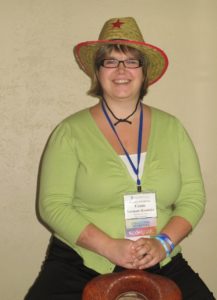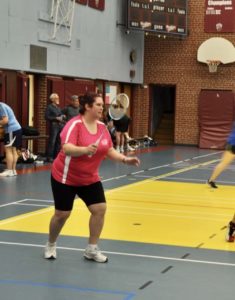By Janane Tan
Growing up in Ontario, Canada, Cassie always knew she was different. As a newborn she was diagnosed with a congenital heart defect called Tetralogy of Fallot and a hearing impairment in third grade. Early in her development, Cassie was diagnosed with Mild Intellectual Disability and later due to legalities in the post-secondary system in Canada she was labeled with Non-Verbal Learning Disorder. Cassie has also lived with mental health challenges since high school.
Cassie was often misunderstood as a child and was bullied by her peers because she was different, but it was not until she was 15 years old that she and her family figured out the full extent of her disorder. Cassie was diagnosed with Complete Agenesis of the Corpus Callosum (ACC).
The way Cassie describes her disorder makes it easier for others to understand.
 “The corpus callosum is the superhighway, sending messages between the two hemispheres of the brain. Imagine this highway and there is an express and a collector (regular highway), a regular person’s brain rides in the express lane while an individual with ACC rides in the collectors back up in rush hour traffic,” said Cassie.
“The corpus callosum is the superhighway, sending messages between the two hemispheres of the brain. Imagine this highway and there is an express and a collector (regular highway), a regular person’s brain rides in the express lane while an individual with ACC rides in the collectors back up in rush hour traffic,” said Cassie.
Through her diagnosis, Cassie’s parents sought ways to help her. Her dad, a paramedic, found the National Organization for Disorders of the Corpus Callosum (NODCC) in 2009. Discovering that there were other individuals with the same diagnosis, Cassie was able to contact and network with new friends from all over the world.
Through the NODCC, Cassie was able to find a real support group that understood her everyday struggles. She noted that finding such support was always complicated in the real world because her disorder was not visibly seen by others. Additionally, Cassie struggled with executive functioning tasks, misreading situations, maintaining stable relations, and helping others. Despite her difficulties, Cassie has refused to let her disorder hinder her development as a person. She ultimately found a strong passion in playing both badminton and volunteering at a mental health facility.
 Cassie was first introduced to badminton in tenth grade through her best friend. Since there were no tryouts, she showed up willing to learn and play badminton. Not only was badminton a way for her to hang out with others, it also provided Cassie with a way to be active without the worry of being judged on her skills. She attributes her ability to build on her skills to her coach, who pushed her to improve her skills through drills. Through badminton, Cassie was also able to improve her hand-eye coordination and depth perception over time. Furthermore, the sport helped build Cassie’s confidence when she realized that she could be a successful, valued member of the team. Badminton was the one non-academic event in her life that allowed her to prove that hard work did in fact pay off and that she was able to accomplish something without any special treatment. For Cassie, badminton was a huge turning point since her diagnosis.
Cassie was first introduced to badminton in tenth grade through her best friend. Since there were no tryouts, she showed up willing to learn and play badminton. Not only was badminton a way for her to hang out with others, it also provided Cassie with a way to be active without the worry of being judged on her skills. She attributes her ability to build on her skills to her coach, who pushed her to improve her skills through drills. Through badminton, Cassie was also able to improve her hand-eye coordination and depth perception over time. Furthermore, the sport helped build Cassie’s confidence when she realized that she could be a successful, valued member of the team. Badminton was the one non-academic event in her life that allowed her to prove that hard work did in fact pay off and that she was able to accomplish something without any special treatment. For Cassie, badminton was a huge turning point since her diagnosis.
As Cassie continued to prove that her disorder was no obstacle in her future endeavors, she decided she wanted to give back to the mental health facility that had once helped her through her struggles. Cassie volunteered at the facility by leading a beading crafts group as well as a writing-for-wellness group. She volunteered around the mental facility so often that participants were coming to her for help as opposed to the staff. Her work as a volunteer not only helped build her social skills but also inspired her to pursue a career path as a social services worker.
Today at age 31, Cassie continues to pursue her diploma in the field of social services. She does so with the intent of re-educating herself and to give back to a field that had once helped her.
“My father said, ‘There are never roadblocks in life, just speed bumps along the way,’” said Cassie. This quote resonates deeply with Cassie.
Cassie has refused to allow her disorder to become a roadblock but rather remain a speed bump. She hopes that the support of others will continue to accompany her and that more support will be provided for adults.
This story is part of the Adults with DCC series that showcases the abilities and lives of real adults living with disorders of the corpus callosum. Students at The University of Texas at Arlington interviewed and wrote stories for this series.

